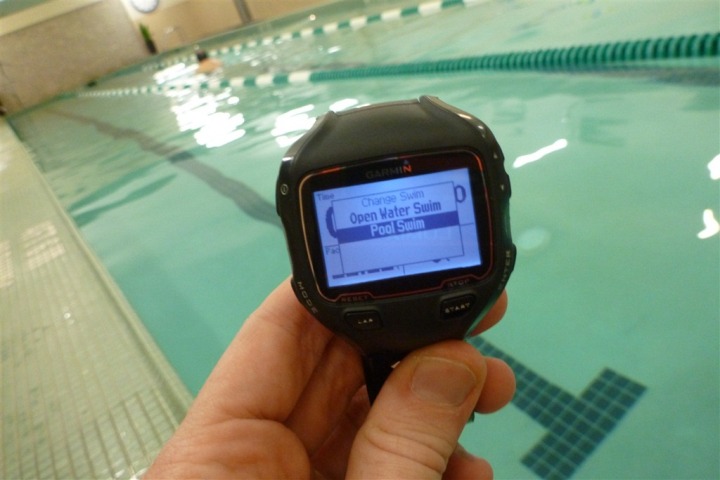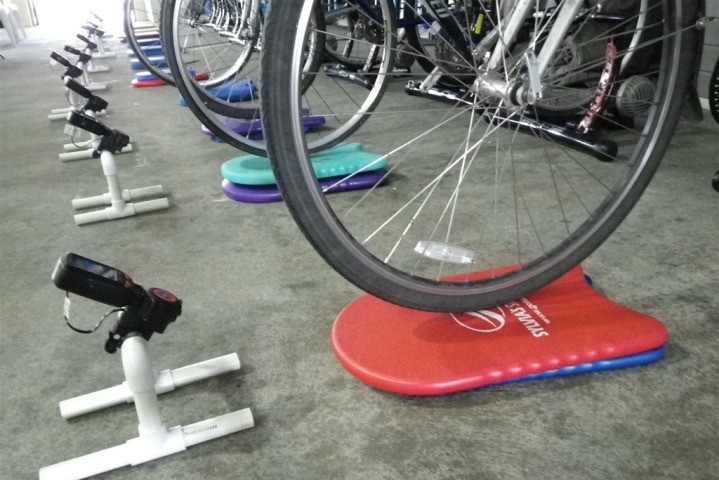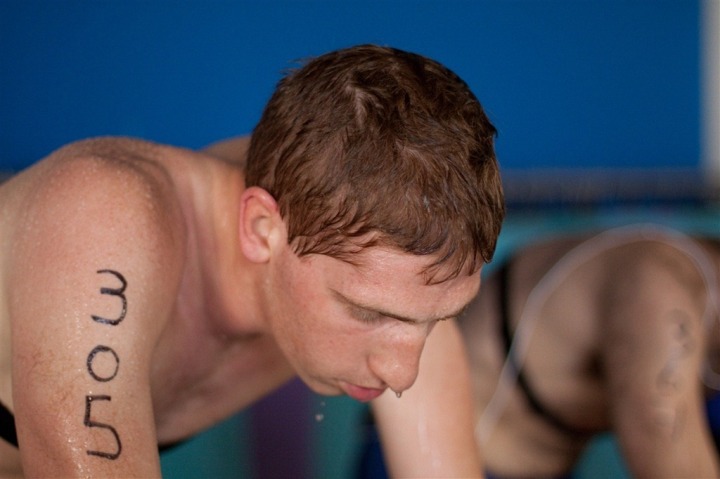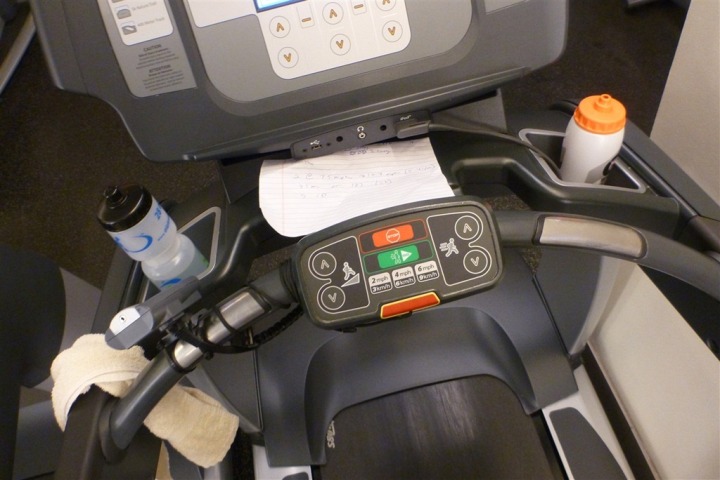This past weekend’s indoor triathlon race got me thinking about how indoor triathlons are in many ways very different tactically than outdoor triathlons. Sure, both have swim/bike/run objectives – but the way in which different indoor races are run forces you to think differently about how to achieve the best overall time.
This time of year, indoor triathlons are fairly popular. This is especially true where the water is still too cold for much of the northern portion of the country. But it’s early enough in the triathlon season that many rec centers put on events as a good way to introduce folks to the sport early enough to get into things for the main portion of the season.
I decided it’d be fun to walk through each sport, and some of my tips on how to do well at indoor triathlons. With that, let’s get cookin’!
The Swim:
Every indoor triathlon will likely feature a pool swim – since that’s usually the main driver for hosting the event indoors to begin with. Given that, most triathlons run the swim portion of the event in one of two ways – so I’ll break down my guidance based on that:
Max distance in allotted time: In this format you’re usually given a set time (i.e. 10 minutes) to swim as far as you can. This method is a bit tricky in that it requires you to really know your splits and pay attention to the clock. It’s a simple game of leaving as little time left on the clock as possible without going over. If you go over – the lap won’t count and you’ll have wasted that time swimming when you could have been recovering. Thus, you’ll want to know what a 50y lap looks like for yourself time-wise, and what the bare minimum amount of time you need is. If you get down to the wire on time, you’ll want to be able to make a split second decision to simply realize that you won’t be able to slide another lap in there. For reference, that’s how an indoor triathlon event I did two years ago was run. And while I didn’t have the fastest swim, I did still have the fastest overall time. :)
Time Trial (set distance): In this case, you’ve got a set distance to cover (i.e. 500 yards), and your swim time is simply recorded as-is. Given you’ll know what this distance is ahead of time, you shouldn’t have too many surprises here when it comes to your finish time. Ensure that you’re pacing yourself at a reasonable pace to not only complete the swim with a good time – but still leave yourself energy to bike and run. If you have a set transition time period that doesn’t count towards your total time, then push a bit harder.
Applicable to both formats: With an indoor swim the wall becomes a fairly critical part of the event. In open water, the flip turn is meaningless. But in a pool, if you’re a triathlete who rarely focuses on either flip or open turns, then now is a good time to try and clean then up ahead of race day. If you can save just 1-second per turn, you’re talking about 20 seconds over the course of a 500y event. Further, in most cases, when you clean-up your flip/open turn, you’ll likely also be coming off the wall faster/harder, which will in turn probably also speed you up a bit as you depart the wall.
Outside of the turn, it’s critical to get some form of warm-up – even if only a few laps. The goal being to minimize the body’s shock when you first start going hard. This of course applies to both indoors and outdoors. Those warm-up laps should be focused on starting off easy and then building to a nice tempo clip. But don’t tire yourself out either, know your limits. In my case this past weekend – I only had a 2.5 lap warmup (125 yards). So I did my first lap easy building, and my second 1.5 laps pretty hard. Ya gotta work with what you have.
If you’ve got a lane partner (or choice in selecting one) – try and find someone just barely faster than you. Anything you can do to increase motivation and get those couple extra seconds is key.
Finally, if you’re in an event where they are doing a snake-swim style indoor swim (I’ve seen it, it’s ugly) – be sure that you’ve aligned yourself in the position closest to your swimming ability. Also, don’t be afraid to let folks ahead of you know while swimming that you need to pass them if applicable (simply tap their toes). Just be careful passing in a snake-swim style event, since you’ll have oncoming swimmers (depending on the lane setup). The wall may be the best spot for a pass to occur.
The Bike:
Like the swim, there tends to be a few formats offered here:
Bring your own bike: In this case, you bring your own bike and place it on one of their trainers. Typically the trainers are controlled such that all are created equal. In some cases, you’re going for a set amount of time, and in other cases you’re going for a set distance. No matter the case, be sure to know how to get the fastest speed out of your bike. At the end of the day, it’s speed that matters here – not power. This means focus on understanding which gear combinations net you the highest MPH/KPH outputs. Typically speaking, you’ll find this to be the big ring in the front, and the smallest ring in the back.
Spin bike scenario: In this case, you’ll want to try and see if your bike shoes are compatible with the pedals on their bikes. In some cases, you can remove the pedals on the bike and replace them with your own. You’ll likely get a fair bit more power output (and thus better efficiency) using clipped in bike shoes over simple running shoes. At the very least though, if you can’t make them work with your bike shoes – then definitely use the cages if provided (or consider changing your cleat for the event). Don’t just place your foot on top of the whole pedal/cage, strap yourself in! Depending on how they are measuring (likely distance) – focus wholly on speed. Fluctuate cadence with resistance to find the fastest speed. In most cases, a higher resistance with a lower cadence will yield a faster pace while indoors (not necessarily true outdoors).
Applicable to all: This is your time to get in some nutrition. If it’s a sprint-like event, then you’ll probably just be focusing on water, or maybe something with a bit of sugar in it. Also, in many indoor triathlon events, the bike portion is held in/around the pool – which means it’s likely hot and humid. Take the time to keep cool. Have towels handy, and water bottles on your bike. If you’re like me and easily overheat – fill them with ice ahead of time. Heck, even have iced towels ready. The goal will be to keep cool.
Finally, depending on how the event is organized, if you can arrange your own bike area – take the time to ensure everything is setup ahead of time. This includes clipping your shoes to your bike, having water bottles ready, having your bike computer on (with the GPS turned off), having it connected to your sensors, and having the towels handy.
The Run:
This is one area where indoor triathlons tend to get the outdoors involved a little bit. For those events where snow isn’t likely outdoors, many often have athletes run outside. So we’ll cover both scenarios:
Treadmill: In the event of a treadmill, spend some time in the preceding weeks running at race pace on a treadmill at 0° incline. Normally you’d want to run at 1° incline to simulate outdoor running – but more than likely the race will be at 0° incline. If you’re not used to that, the treadmill may seem a bit faster than you’re used to. So try and spend some time at the gym ahead of the race, running on the treadmill at race pace. Also take note that treadmills increase speed at different paces – finding the treadmill that increases speed the fastest can save you valuable seconds.
When you initially start the treadmill, the timer will begin as soon as the belt moves. Unfortunately, this is usually at about 1.0MPH. Look for quick-pace buttons, typically at 2MPH, 4MPH, and 6MPH – to instantly change the set pace to the higher value, then from there increase as applicable. In my case, I pressed the 6MPH button, then instantly pressed ‘Increase speed’ as fast as I could to get it up to speed. In my case, my coach had me build the pace up over the first 60-90 seconds, before basically taking the ‘set it and forget it’ approach. This meant going from 0 to about 9.5 as fast as possible, then getting the remainder of the way to 10.0 and beyond at about the 70 second marker. Obviously, your pace will differ.
After about 90 seconds, I focused on the speed I thought was maintainable, and then went at it. As I got into the final mile (of the 5K race), I increased it a fair bit more.
The key here is taking advantage of the fact that the treadmill does some of the work for you (especially at 0° incline) – you’ve just got to avoid flying off the back. So as long as you can keep the legs turning over, as you near the end – just try and go with the flow. Plus, it’s more fun that way.
Outdoor race: In this case, there’s not much special about the outdoors that you wouldn’t do in a regular triathlon race. Remember however that if it’s hot and warm inside, and you’re sweaty and drenched – that it may come as a shock if you run outside into 40°F weather. So consider the outside weather as you depart the building – especially depending on how long you expect to be outside running.
Transitions:
Depending on how the event is organized, transition times will either be A) Recorded separately B) Built into the times of your specific sport activities, or C) Not recorded at all.
In the case of A & B, you’ll want to pre-setup everything just like you would when outdoors. The one advantage you have here though is that your bike isn’t moving anywhere. Thus, treat it a bit more like a temple to store stuff, than a place to avoid sticking stuff. For example, anything you might need on the run, you should have on your bike. Be it tied on, or somehow hanging there. That way as you wrap up the bike ride you can be stashing that stuff so that the only thing you need to do once dismounting your bike is put on your running shoes. Examples of items can include a different shirt to change in for the run (if cold outside), or a race number to put on.
If you have a non-recorded transition time – consider it free time, and focus on spending that time in the most beneficial way possible. In my case this past weekend, it was trying to cool down outdoors. But for others, it may be stretching to not get too tight. Or, for some, it may be a briskly walking circles to keep warmed up. And finally, it may be taking in some hydration/nutrition. Whatever your plan is – by all means, have a plan (aside from watching Jerry Springer on the gym’s TV’s…).
Wrap-up:
With that – you’re now armed with all the tools to kick butt while racing inside. Just as in outdoor triathlons, the race is often won or lost with attention to detail and focusing on all the little places to save time.
I’d love to hear your tips as well for racing indoor triathlons! Especially if you’ve got scenarios not covered above. I have no doubt that creative gyms across the world have come up with some pretty innovative indoor triathlons.
Thanks for reading!
FOUND THIS POST USEFUL? SUPPORT THE SITE!
Hopefully, you found this post useful. The website is really a labor of love, so please consider becoming a DC RAINMAKER Supporter. This gets you an ad-free experience, and access to our (mostly) bi-monthly behind-the-scenes video series of “Shed Talkin’”.
Support DCRainMaker - Shop on Amazon
Otherwise, perhaps consider using the below link if shopping on Amazon. As an Amazon Associate, I earn from qualifying purchases. It doesn’t cost you anything extra, but your purchases help support this website a lot. It could simply be buying toilet paper, or this pizza oven we use and love.


























even in sunny san diego. December thru February.
link to pedpowerperformlab.com
This is comprehensive and informative…should I ever find myself doing an indoor tri (it will probably happen at some point). Thanks for the in depth analysis.
I think that all triathletes should train with flip turns – the way that most of them do open turns, they are getting a good 2-3 seconds of rest at each wall. With a flip turn done properly, you kick hard off the wall and really get little rest. A far more reasonable simulation of a 1-2 mile open water swim.
It’s not that hard to do – maybe you need a “how to” post on flip turns.
Lifetime Fitness always has a winter indoor triathlon at most of it’s locations. This year they are done on the same day instead of different Saturdays in Jan.
link to indoortri.com
This is a great article. The spin bike is like a video game, that rewards tension versus rpm. That was what I was looking for. As a fellow swimmer, I thought your tips were spot on. Thanks.
When talking about transition from swimming pool to a spin bike. Is it worth it to change your shoes twice? I’m doing 500m/20k/5k and I’m wondering if I will get a benefit from using cycling shoes on a 20k spin bake race. If I bike and run in my running shoes I will save some time during transition. I will of course use the cages. What do you think is better?
It probably depends a bit on:
A) Whether or not the bikes will even have pedals for your cycling shoes
B) How efficient a cyclist you are.
For me, I’d probably have some notable gains using cycling shoes over running shoes, but only if the bike is properly setup for me. If however, you’re talking cycling shoes inside of cages, then no, I’d definitely go running shoes there.
Thanks for taking your time to reply. It really means a lot to me.
I’m just beginning my journey into triathlon. This is my second indoor sprint, but I’m training for tri for 3 months now, and by the end of the season I’m planning to start on 1/4 IM. Previously I was doing CrossFit for 3 years.
Pedals are two-sided with cages on one side and compatible SPDs on the other. They will fit, but will they give me enough gain to justify time wasted on changing them? If I understand correctly, you clip your shoes into the bike before the race and just slip your feet in during the race?
Also, what is the best tactic for this kind of effort? From what I understand from the article, I should have harder resistance with lower cadence ? What is the cadence I should maintain? 70 rpm? What do you think about standing up and climbing with higher resistance for some time?
Thanks